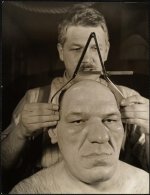What's the origin of the European facial shape differentiation? I'am special interested in the origins of 'big broadheads', so with a broad bizygomatic.
View attachment 8182
What is their origin:
- hunter-gatherers DNA (WHG)? Cro-magnoid?
- Steppe DNA (ENA)?
- ....or?
Eurogenes has given some
hints, some SNP, but not much concrete background.
Anyone?
Thanks in advance!
"cromanoids": all the preNeolithic pops of Europe have been named likewise spite their origins are in at least two big phyla: a western well identified 'cro-magnon' type, very homogenous, and a 'capellid-brünn' type; based on diverse means of diverse places and time, it seems to me the European mesolithic pops were for the most mixtures of this two basis, with more or less dominance in traits (not genetical dominance) to one or another, but surely local isolations and drift and selection so local types in fine - I'm not sure but I wonder if after redeployment after LGM some pops have not taken a more sedentary way of life with beginning of gracilization and lost in size, in West. The so called steppic eastern Europe 'cromagnoids' could be ONE of the results of these previous crossings (local selection and drift); I'm not sure they were so homogenous.
'cro-magnons' are typically subdolichocephalic (mesocrane) with broad and short faces, square shallows but robust jaw, protuding "horizontal" chin, and spite their cheekbones are broad (logical!) the ratio bizygomatic/bigonials is rather temperate; the other phylum ('cap-brünn) was higher faced, large faced, broad ennough cheekbones but very narrower for jaws spite heavy and robust, and had a bigger ratio bizygomatic/bigonials; the few eastern HG's I saw (reconstructed: caution) were all on the 'brünn' side for this ratio, spite they had rather broader faces than the original 'brünn' types; on another side, they have very more receding frontals and strong browridges compared to western 'cro-magnon' what pushed them closer to 'brünn' too.
&: when I look at some of some eastern HG's of Russia, I wonder if they don't show something "northeast-amerindian" !?! Just personal guess without sufficient data.
So speaking of bizygomatic is not sufficient but it's sure the archaic types had more often cheekbones exceding largely the frontal and temporal breadth; for cro-magnon and partial "heirs" it's normal considering their broad total face; for 'capellid-brünn' types it's not so clear; IMO the explanation by lone masticatory constraints is not sufficient, far from it, concerning cheekbones.
&&: one of the today problems for me is that - if I red well - new metric surveys don't care too much of jaws breadth, perhaps because jaws are often lacking or they are hard to link to correspondant skulls??? I don't know.
I'm sorry I don't know anything to date concerning the auDNA linked to these features. I suppose only the attribution of some features to some pairs or groups of genes could be more difficult than for pigmentation, which is already not so simple.
I don't know about other big modern human groups but 'east-asian and 'SSA people' had very often broad cheekbones compared to other segments of their anterior crania (east-asian cheekbones angles more forwards I think). BTW typical 'neanderthal' types have less prominent cheekbones spite the anteriority of their form in Europe.




